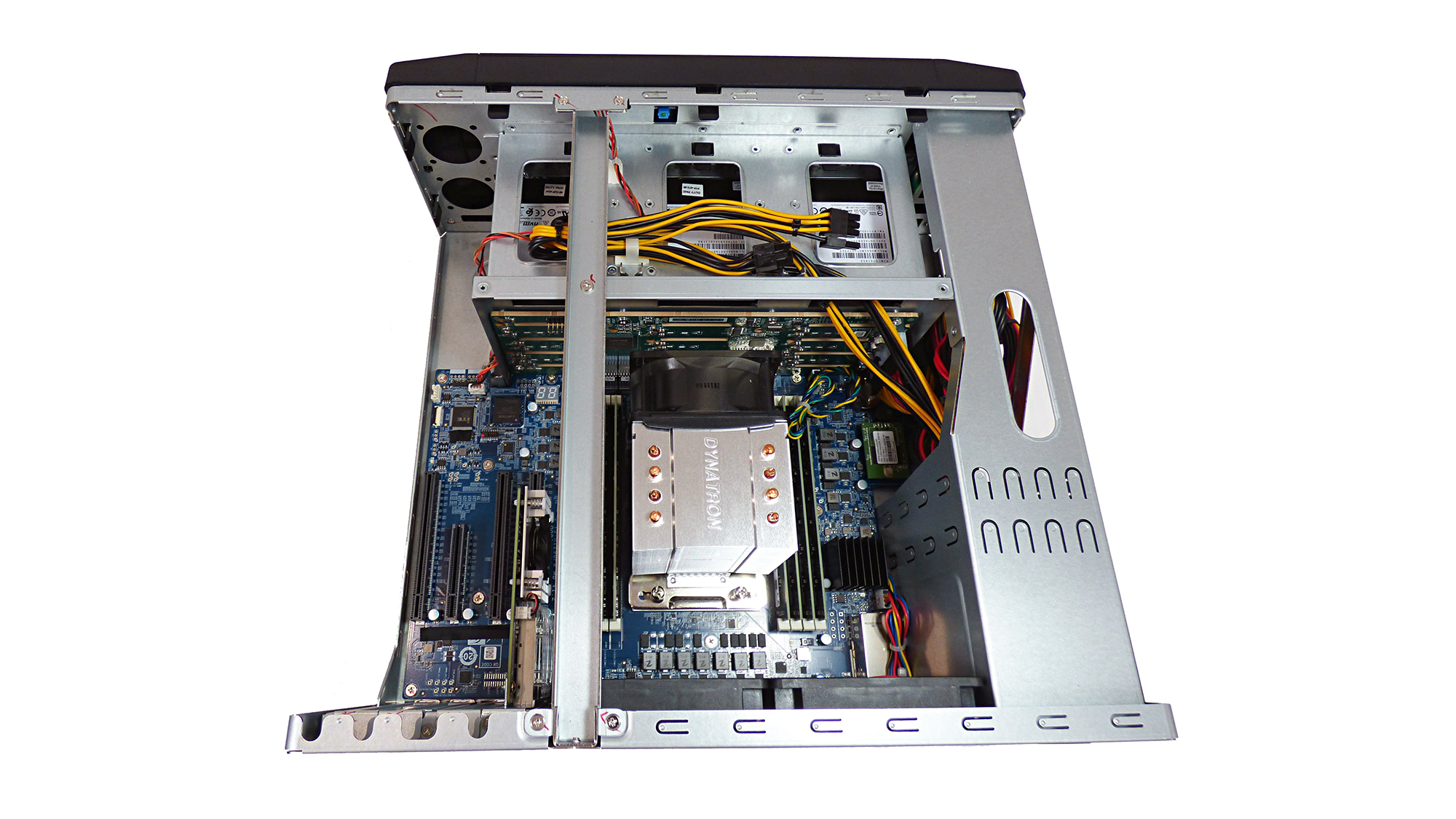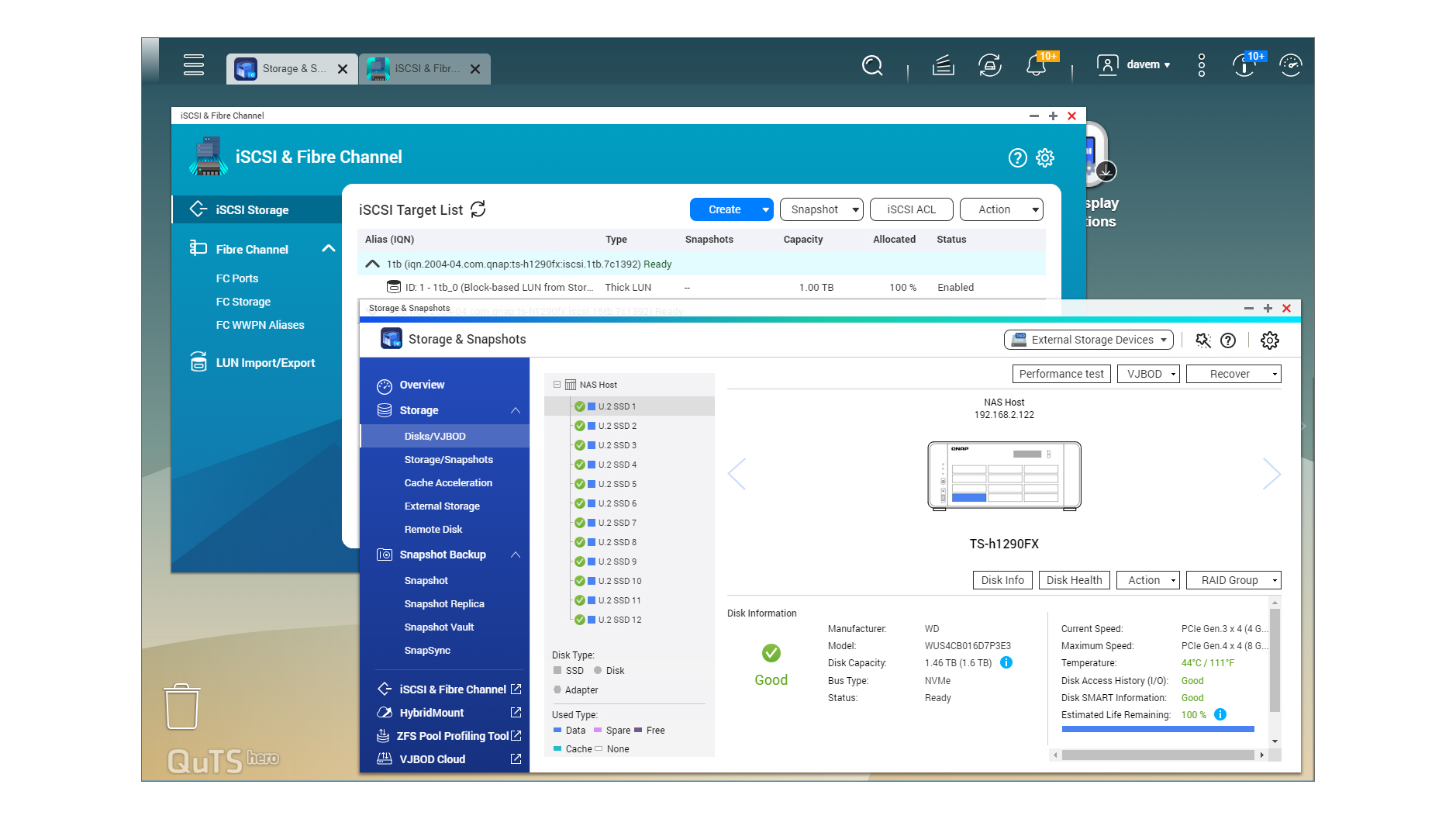Qnap TS-h1290FX review: Flashy desktop storage
A sleek and affordable desktop NVMe all-Flash array that delivers great 25GbE performance


-
+
Great value
-
+
AMD EPYC CPU
-
+
Big memory capacity
-
+
Supports U.2 NMVe and SATA devices
-
+
Good overall 25GbE performance
-
+
Very quiet
-
-
Memory supplied on eight 8GB modules

Qnap’s mighty TS-h2490FU enterprise all-Flash array (AFA) impressed us when we reviewed it last year, with a combination of pure NVMe performance and value that will appeal to budget-conscious businesses. Not content to rest on its laurels, Qnap now makes a 12-bay desktop version available for SMBs and large teams that want fast data access and run demanding workloads such as real-time 4K/8K video editing.
The TS-h1290FX will appeal to smaller offices in particular, as this compact tower is designed to be super quiet. This doesn’t come at the cost of features either, as the appliance is available with a choice of three AMD EPYC 7002 Gen 2 CPUs, has room for up to 1TB of DDR4 memory and offers all the expansion potential you could possibly want.
All three models come with pairs of embedded 2.5GbE multi-Gigabit and 25GbE SFP28 ports, and the four free PCI-E 4 expansion slots means there’s plenty of room to add a lot more. You can also balance storage costs with performance requirements, as unlike the TS-h2490FU (which only supports U.2 form-factor NVMe SSDs), the TS-h1290FX also accepts SATA SFF HDDs and SSDs.
Qnap TS-h1290FX review: Build quality and hardware features
We’ve reviewed the base model, which sports an 8-core AMD EPYC 7232P CPU teamed up with a decent 64GB of DDR4 ECC memory. A minor complaint is Qnap supplies the memory as eight 8GB DIMMs, so any upgrades will require some or all of them to be replaced, as there aren’t any spare slots.
Its slick design means the TS-h1290FX will look good on your desktop and we can’t fault build quality either; it’s presented in a sturdy pressed steel shell with a solid metal cover. Removing the lid reveals a tidy interior, with the AMD CPU topped off with a large active heatsink and easy access afforded to all PCI-E and memory slots.
A meaty 750W internal PSU sits at the rear and alongside are two 9cm cooling fans, which we found to be barely audible in our office environment – even under heavy load. A nice touch is the appliance supports plenty of GPGPU cards and Qnap has fitted two extra cables to provide additional power for them.

The two rear USB 3.2 ports can be used to add Qnap’s disk expansion tower or rack units for a cheaper, high-capacity storage vault for services such as backup. If you want better performance, the appliance accepts Qnap’s SATA and SAS expansion cards.
Sign up today and you will receive a free copy of our Future Focus 2025 report - the leading guidance on AI, cybersecurity and other IT challenges as per 700+ senior executives
Qnap TS-h1290FX review: OS choices and apps
You can choose from Qnap’s QTS or QuTS operating systems during installation and we recommend the latter if you want the best data protection. Both present almost identical web consoles, but delve deeper into QuTS and you’ll find this 128-bit ZFS-based OS offers valuable features such as near unlimited NAS share and iSCSI LUN snapshots, end-to-end checksums, encryption, inline data deduplication and compression.
There’s more as along with the usual RAID suspects, QuTS supports triple parity RAID to protect against three drive failures, and triple mirroring which stores identical copies of your data on three drives. NAS share data can also be protected from tampering by applying one of two WORM (write once read many) policies.
For IP SANs, you use the standard iSCSI & Fibre Channel app and during LUN creation, you can apply thick or thin provisioning, deduplication and compression. NAS and iSCSI snapshots are easily created from the Storage & Snapshots app and can be run manually or scheduled for as often as every five minutes.
There’s no shortage of apps for the TS-h1290FX: we counted nearly 100 available in its download support page. All backup and file syncing apps are present and include Hybrid Backup Sync (HBS) 3, Qsync Central and HybridMount plus Hyper Data Protector for protecting VMware and Hyper-V virtualised environments.

Qnap TS-h1290FX review: 25GbE performance
For our lab testing, we fitted a full house of 1.6TB WD DC SN640 U.2 NVMe SSDs in the appliance and created a single RAID5 array. Our test host was a Dell EMC PowerEdge R650xs rack server equipped with dual 28-core Xeon Scalable Gold 6330 CPUs, 256GB of DDR4 and two dual-port 25GbE network cards, with Windows Server 2022 at the helm.
NAS performance over 25GbE is excellent. With a share mapped to our test server over a single DAC (direct access cable) connection, Iometer reported 23.1Gbits/sec both for sequential reads and writes with random operations returning 23Gbits/sec and 22.8Gbits/sec.
IP SAN speeds over 25GbE are equally impressive, with a 1TB iSCSI target returning Iometer sequential read and write speeds of 22.8Gbits/sec and 23.1Gbits/sec with I/O throughputs using 4KB block sizes measured at 163,200 and 142,200 IOPS. Moving to random operations saw 22.3Gbits/sec and 22.8Gbits/sec and 162,800 and 99,800 IOPS.
Stepping up to a dual 25GbE MPIO connection saw sequential and random speeds increase to 37.7Gbits/sec and 41.1Gbits/sec and 37.4Gbits/sec and 39Gbits/sec respectively. Throughput numbers for sequential and random operations improved to 215,300 and 205,210 and 206,300 and 115,100 IOPS.
With an extra Qnap dual-port SmartNIC 25GbE PCI-E card fitted in the appliance, we created a quad-port MPIO connection and recorded sequential and random read and write speeds of 58.9Gbits/sec and 59.5Gbits/sec and 50.2Gbits/sec and 51.5Gbits/sec. IOPS numbers for sequential and random operations saw reasonable increases to 307,500 and 310,200 and 304,300 and 135,400.
Qnap TS-h1290FX review: Verdict
The TS-h1290FX impresses on many levels; this quite unique desktop AFA combines a dozen PCI-E 4 NVMe SSDs with a powerful AMC EPYC processor and delivers it all at a remarkably good price. Add in the integral 25GbE ports and great performance, and you have a storage system that will undoubtedly satisfy content creators, video editors and businesses that need super-fast access to their data.
Qnap TS-h1290FX specifications
| Chassis | Desktop |
| CPU | 8-core 3.1GHz AMD EPYC 7232P |
| Memory | 64GB DDR4 ECC (max 1TB) |
| Storage | 12 x SATA SFF/U.2 NVMe SSD hot-plug bays |
| RAID | Qnap QTS or QuTS |
| Array support | RAID 0, 1, 5, 6, 10, 50, 60, (QuTS) - Triple Parity, Triple Mirror |
| Expansion | 4 x PCI-E Gen 4 |
| Network | Embedded 2 x 2.5GbE and 2 x 25GbE SFP28 |
| Other ports | 3 x USB 3.2 Gen1 |
| Power | Internal 750W PSU |
| Management | Web browser |
| Warranty | 5 years standard |
Dave is an IT consultant and freelance journalist specialising in hands-on reviews of computer networking products covering all market sectors from small businesses to enterprises. Founder of Binary Testing Ltd – the UK’s premier independent network testing laboratory - Dave has over 45 years of experience in the IT industry.
Dave has produced many thousands of in-depth business networking product reviews from his lab which have been reproduced globally. Writing for ITPro and its sister title, PC Pro, he covers all areas of business IT infrastructure, including servers, storage, network security, data protection, cloud, infrastructure and services.
-
 UK government to fund regional tech programs up to £20m
UK government to fund regional tech programs up to £20mnews Local and regional partnerships invited to bid for support for established or developing projects
By Emma Woollacott Published
-
 "There is a pressing need to address 'technostress' head-on" – Knowledge workers stressed and anxious thanks to tech
"There is a pressing need to address 'technostress' head-on" – Knowledge workers stressed and anxious thanks to technews Notification overload and platform juggling leave many looking for a new job
By Emma Woollacott Published
-
 Middlesbrough Council boosts cybersecurity spending, strategy in response to repeated cyberattacks
Middlesbrough Council boosts cybersecurity spending, strategy in response to repeated cyberattacksNews Councils across the UK have publicly struggled with maintaining services in the face of major cyber disruption
By Rory Bathgate Published
